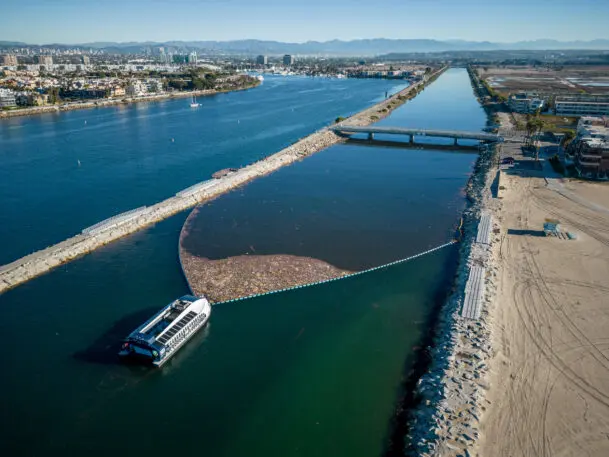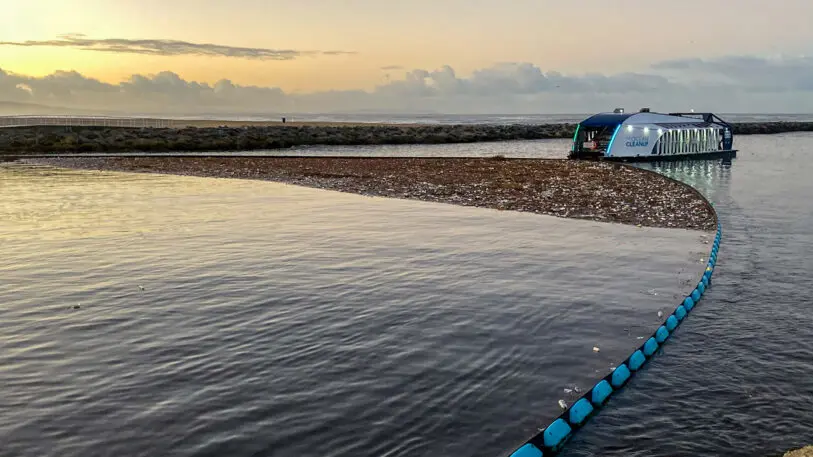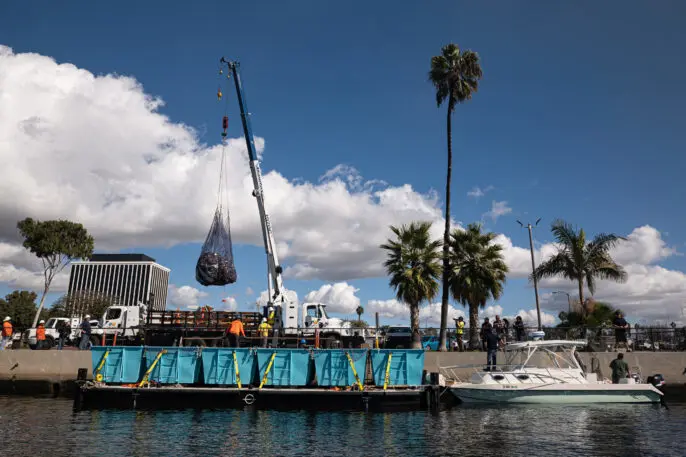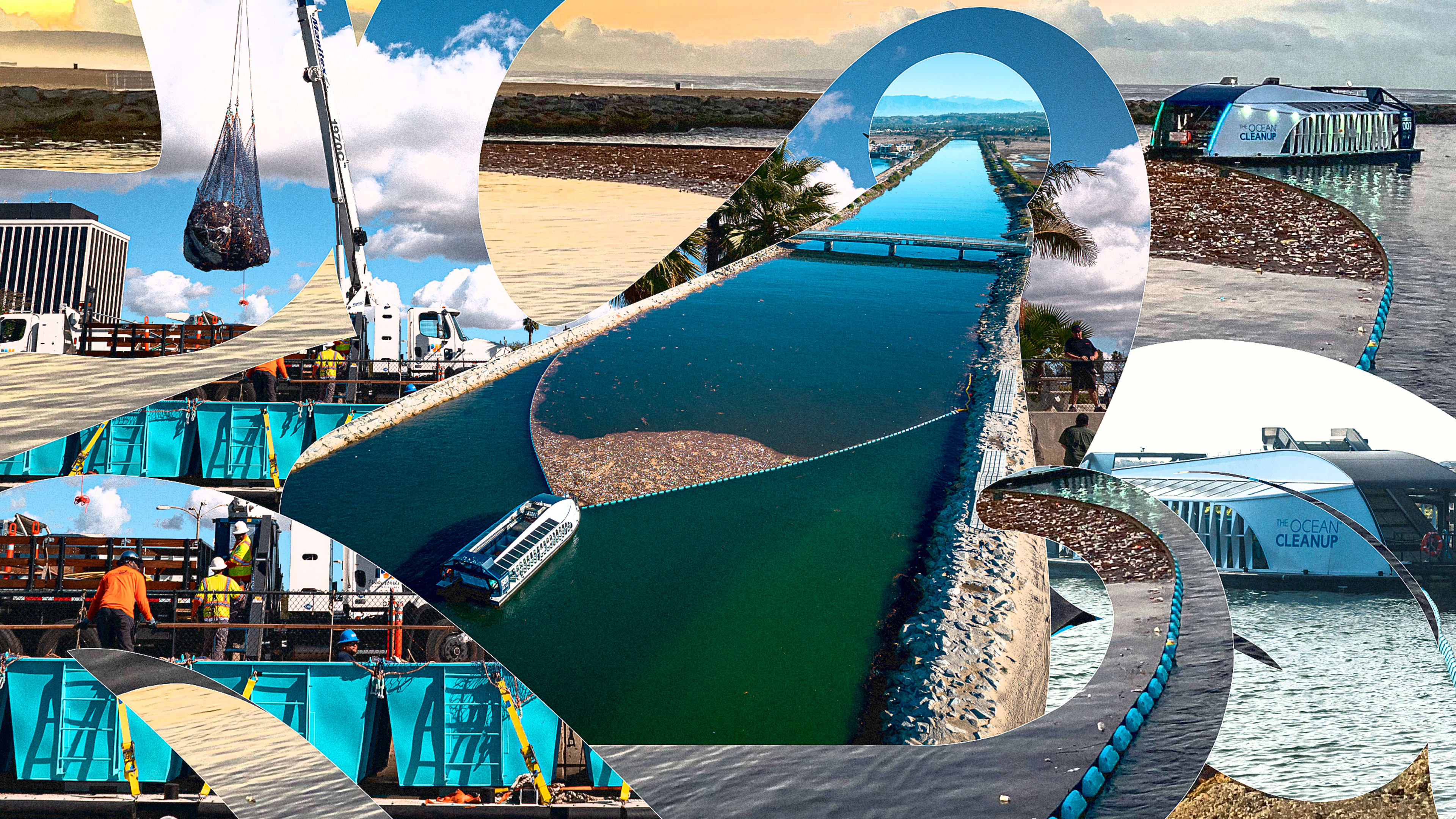When heavy rain fell in Los Angeles last November, trash on city streets started washing into Ballona Creek, a 9-mile-long river that flows to Santa Monica Bay. Normally, a storm coming after months of dry weather would push thousands of pounds of debris and litter, including plastic bottles and bags, into the ocean. But a month before the November storm, a new floating barrier was set in place at the end of the river.
As the rain fell, trash began to collect against the barrier while a solar-powered conveyor belt—housed inside a sleek white floating platform— pulled it out of the water. The machine automatically filled dumpsters on an attached barge that could later take the garbage away for sorting and recycling.
Over the course of the two-day storm, the device collected more than 35,000 pounds of trash. When the rain stopped, workers took the barriers down so local kayakers could pass through.

The tech, called the Interceptor, is the latest installation from Netherlands-based nonprofit the Ocean Cleanup, which now has different versions of the equipment in 10 rivers around the world. (L.A.’s is the first in North America.) In some locations, like Ballona Creek, it can block nearly all of the trash from reaching the ocean.
Ideally, of course, trash wouldn’t end up in rivers in the first place. “The dream is that Interceptors are not necessary anymore,” says Ocean Cleanup CEO Boyan Slat. (The nonprofit is also known for trying to remove plastic from the Great Pacific Garbage Patch, something it also wishes wasn’t necessary.)
“However, we are under no illusion that that future will occur anytime soon,” he says. “If you look at all the trends, plastic production will increase. Plastic consumption will increase. There’s huge geographic disparity still between plastic consumption in the West versus in lower-to-middle-income countries. So realistically, the top of the funnel is only going to grow in the next few decades.”

Slat says having the visible barriers in place can help build support for more systemic solutions. In the Dominican Republic, where another one of the devices is installed in a local river, it started a conversation about plastic waste.
“Nobody was talking about the plastic issue in the DR,” Slat says. “We brought the Interceptor there, it became this local icon—it was on all the news channels, [in] all the newspapers, everyone was talking about it.” It helped catalyze plans for new recycling infrastructure that the U.N. Development Program later installed in low-income communities along the river.
In L.A., where a full recycling system already exists—and the recycling rate is higher than in most American cities—having the Interceptor visible from a popular biking and walking trail might help more people think about how to better avoid the waste that’s still escaping. (One bigger challenge is the area’s homelessness crisis, and the fact that people living outside often have no good place to put trash.) It could also be a simple reminder not to toss old water bottles in overflowing bins near water. The county installed a sign near the device to introduce the technology to people passing by.

“We’re using the novelty and the fact that it’s an elegant-looking machine,” says L.A. County Public Works spokesperson Kerjon Lee. “It’s a conversation starter, [which] we’re using . . . to kind of guide people toward changing their behaviors.”
The county uses other tools to try to keep trash from reaching the ocean, Lee says, including a net farther upstream in Ballona Creek. But that net has to be emptied manually, and in a heavy rain it can overflow. The Interceptor can catch what escapes, and as it automatically fills up dumpsters, it sends a notification to a barge operator when the trash is ready to be towed to a nearby pier where it can be sorted. Natural debris, like sticks and palm fronds, is composted. Plastic and other recyclable materials are recycled.

So far the device has proven that it’s “pretty exceptionally high in terms of efficacy,” Slat says. But every river is unique, and the same design won’t work globally.
In a river in Guatemala that’s so thick with plastic in the rainy season that “you just can’t see the water,” he says the nonprofit is still trying to find a solution. Its first design, a large fence inspired by avalanche protection systems, wasn’t strong enough to hold back the onslaught of plastic in a heavy storm, so the team will soon begin testing a new prototype.
Another heavily polluted river, in Jamaica, successfully uses a system similar to the one in Los Angeles. Originally, Slat says, the team hoped to have a design that could work anywhere, but they realized that local conditions demand multiple options.
In L.A., the new Interceptor will stay in place for two years as a pilot, as the county tests how well it works and makes sure that it doesn’t have any negative impact on wildlife or neighbors, who were initially skeptical about how the new system would look and sound. If all goes well, it could become permanent.
As the nonprofit adds the equipment in more places, it plans to focus on rivers that are both especially polluted and where the tech can help the most. There are also plans to expand in countries like Indonesia, where the Ocean Cleanup already has its technology in place.
“Scaling within a country where we are already active, if we already have a network built up, is much easier than just going into a new country where we’ve never done anything before,” Slat says. “So we will aim for as much geographic focus as possible for the next set of deployments.”
Indonesia is one of the world’s hot spots for plastic waste, with more than 4.9 million tons of it ending up in open dumps or the environment each year.
Recognize your brand’s excellence by applying to this year’s Brands That Matter Awards before the early-rate deadline, May 3.
